|
|
|
Sort Order |
|
|
|
Items / Page
|
|
|
|
|
|
|
| Srl | Item |
| 1 |
ID:
159256
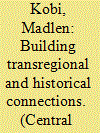

|
|
|
|
|
| Summary/Abstract |
Economic investment and the growing immigration of Han Chinese from other parts of China to the Xinjiang Uyghur Autonomous Region over the last three decades have increased the presence of eastern Chinese architecture in the urban built environment. This paper refers to the making of, residing in and speaking about the materiality of urban architecture by Turkic-speaking Muslim Uyghur middle-class actors. Besides creating personal comfort through Uyghur elements they draw ethnic boundaries to the Han Chinese. In highlighting the materiality of architecture, the analysis expands beyond the individual house by investigating the ways in which urban architecture offers spaces of meaning for social and ethnic communities. Based on ethnographic data, this paper argues that due to the political context and the state-controlled urban development with Chinese characteristics, urban Uyghur architecture was relegated from the outside of houses to an emphasis on interior decoration.
|
|
|
|
|
|
|
|
|
|
|
|
|
|
|
|
| 2 |
ID:
188947
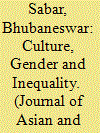

|
|
|
|
|
| Summary/Abstract |
This ethnographic paper explores gender inequality in tribal societies vis-à-vis customary practices and challenges the notion of egalitarianism of tribal society by taking Chuktia Bhunjia tribe of Odisha, India as an analytical category. In the light of a discussion on women specific taboos and restrictions, captured through formal interview, narrative and lived experience approach, the paper explicates the deeply embedded nature of the taboos in Chuktia Bhunjia society and unravels how prohibiting women from socio-economic and religious space, backed by purity-pollution philosophy, perpetuate the gender inequality among them. It was found that although economic division of labour is indistinct; women are perceived being portrayal of misfortunes during perceived pollution periods and are prohibited to enter into sacred places – kitchen room, cowshed, sacred groves and forest – and take part in community festivals and other auspicious occasions. The existing material culture, especially kitchen room, alongside economic structure, self-notion of ‘outsiders’ and apparently fixed customary laws have direct influence on the position of women in this society. It is found that the customary laws are not mere symbolic expressions in perpetuating the gender asymmetry, but have become a powerful tool to patriarchal controls not only over women’s education, health, properties and knowledge, but also over individual’s choice, freedom, decision-making and sexuality. However, internal challenges are reported against customary laws and taboos, the fear of social ostracism, the obligation to restore the purity of cultural entity and anxiety reinforce people to be always submissive to those practices. Therefore, unless there is transformation alongside their culture, it is fruitless to think of gender equality.
|
|
|
|
|
|
|
|
|
|
|
|
|
|
|
|
| 3 |
ID:
170701
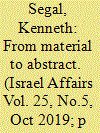

|
|
|
|
|
| Summary/Abstract |
Design anthropology has developed to become an influential sub-discipline occupied with both theoretical and applied knowledge targeted at designers’ real-life challenges. Bearing this in mind, in the last decade we have developed this attitude into a methodology centered around the identification and development of ‘cultural objects’ that can be implemented with insight and understanding within a conventional design process. This methodology isolates and magnifies the cultural aspects of objects and harnesses these to design new hybrid objects that reinterpret and translate cultural values and characteristics into a local context. This paper presents one of the various approaches dealing with the interpretation of philosophic, religious or socio-cultural principles of different cultures through an Israeli designer’s eyes. In this case the re-interpretation of Japanese, African or American cultures of wood and materializing various cultural traits led the students to an intricate and meaningful design process. From the results we recognized two points of significance: understanding that designing and researching through the isolation of a specific material (i.e., wood), the anthropological design process is crystalized and produces profound results that are culturally centered; the second was an insight into how young Israeli designers presented a unique and innovative approach towards contemporary Israeli design through the culture of wood.
|
|
|
|
|
|
|
|
|
|
|
|
|
|
|
|
| 4 |
ID:
145996
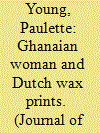

|
|
|
|
|
| Summary/Abstract |
This essay explores the role of textiles, particularly Dutch wax prints, in the lives of women in Ghana, West Africa. Wax prints are colorful message-bearing printed cloths produced in Holland, based on Indonesian batik designs that express meaningful messages. Central to this discussion is the practice of counter-appropriation, that is, how women as individuals are in dialogue with culture by transferring the foreign, in this case Dutch wax prints, into the local in a culturally appropriate way. It positions women not only as cloth distributors and consumers, but also as producers of knowledge through the phenomenon of naming.
|
|
|
|
|
|
|
|
|
|
|
|
|
|
|
|
| 5 |
ID:
144690
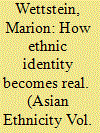

|
|
|
|
|
| Summary/Abstract |
Taking the material and performative world of the Nagas in Northeast India by way of example, this paper examines how identity, above all ‘ethnic’ identity, is manifested and gets incorporated into the understanding that people have of themselves. Following the shifts in identity over time by comparing ritual performances at the turn of the last century with present-day festivals in Nagaland, it is argued that the enactment of identity roles in public performative events provides a mechanism that makes identity concepts such as ‘ethnic identity’ real to people. The liminoid state during the performance enables individuals to live through identity roles emotionally, mentally, and somatically. It is suggested that the enactment of identity roles in public performances can thus be taken as a key to explain why and how identities can shift over time and between contexts.
|
|
|
|
|
|
|
|
|
|
|
|
|
|
|
|
| 6 |
ID:
154723
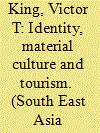

|
|
|
|
|
| Summary/Abstract |
In this study of the relationships between identity, material culture and tourism some of the different roles of the anthropologist in engaging with the wider field of cultural identity are examined. It commences with the approach of the conceptually-oriented anthropologist in addressing issues of culture, identity and ethnicity. Then it explores the role of the anthropologist in an applied mode with regard to the ritual cloths of the Iban of Sarawak, Malaysia. It argues for the importance of advocacy and persuading governments to acknowledge the importance of material emblems of identity and to ensure that indigenous knowledge and skills are sustained and contribute to local livelihoods. Finally the study considers the anthropologist as tourist and the ways in which an informed mode of travelling, in this case engaging with North-west Coast American/Canadian Indian totem poles, can contribute to the development of a comparative anthropology of tourism. It is argued that comparisons between Sarawak and the North-west Coast in the context of issues of identity, material culture and tourism can contribute to an understanding of the ways in which items of material culture are deployed and transformed in globalising processes of identity construction and transformation.
|
|
|
|
|
|
|
|
|
|
|
|
|
|
|
|
| 7 |
ID:
193489
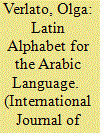

|
|
|
|
|
| Summary/Abstract |
This article explores early attempts to romanize the Arabic language in late nineteenth and early twentieth-century Egypt and situates them within a global history of script reforms in the modern period. I focus on the models to write Arabic in the Latin script developed by the Cairo-based magazine al-Muqtataf between 1889 and 1897 (which, to the extent of my knowledge, have never been examined before), relating them to the responses they elicited from the magazine's readers and some of the romanization practices found in advertising, commercial displays in the streets, and governance at the time. I demonstrate that, in this period, romanized Arabic was envisioned as an original way to pursue financial profit and technological efficiency, confront European knowledge production, and redefine the standing of Arabic within transregional publishing networks that encompassed different languages and alphabets. This analysis thus offers an alternative geography of script reform that supersedes the national framework.
|
|
|
|
|
|
|
|
|
|
|
|
|
|
|
|
| 8 |
ID:
128483
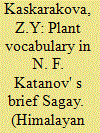

|
|
|
|
|
| Publication |
2013.
|
| Summary/Abstract |
Nickolay Fyodorovich Katanov was a great scholar, who gathered the richest material in ethnography, linguistics and folklore, providing a valuable source for studying different sides of the Turkic peoples' life, including Khakasses. Being a linguist- Turcologist N. F. Katanov started his scientific work with the study of the Khakass language, which he spoke, and relying on its knowledge, he began to research other related kind red languages. During his study in Krasnoyarsk high school, he went to various places every year, gathered folklore, linguistic texts and described the customs of the Sagay people. A researcher of the Tatar language D. G. Tumasheva notes: "Nicloloy Fyodorovich was not only an educated and intelligent man but he had his own material, which had been written by him from the first hand through direct contact with the people. N. F. Katanov laid emphasis on the latter, considering the necessity to study a language by means of direct interaction with the people and not by separating history of a language from ethnography, folklore and history of material culture."
|
|
|
|
|
|
|
|
|
|
|
|
|
|
|
|
| 9 |
ID:
152354
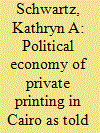

|
|
|
|
|
| Summary/Abstract |
This article examines the political economy of Cairo's emerging Arabic private printing industry during the third quarter of the 19th century. I use the constituent texts of the industry to demonstrate that it developed upon the speculative model of commissioning, whereby individuals paid printers to produce particular works of their choosing. Commissioning indicates that Egyptian private printing grew from local traditions for producing handwritten texts. Nevertheless, print commissioning differed from manuscript commissioning by requiring individuals to assume great financial risk. I explore the nature and implications of this divergence through a treatise published in 1871 by Musa Kastali, a particularly prolific printer who helped to professionalize Cairene printing. Musa's treatise details his legal battle with a famous Azhari commissioner, and is unique for describing a printer's business practices. It demonstrates the importance of situating printings within their socioeconomic contexts in addition to their intellectual ones, a task which cannot be done without an appreciation for the functioning of the printing industry at a local level.
|
|
|
|
|
|
|
|
|
|
|
|
|
|
|
|
| 10 |
ID:
190308
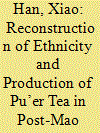

|
|
|
|
|
| Summary/Abstract |
In post-Mao China, the Bulang ethnic group in Yunnan province use Pu’er tea cultivation as a primary way of reconstructing their ethnic identities and cultural traditions. In this paper, I argue that in the process of ethnicization, material culture is a critical factor in addition to myth, history, religions, and cultures, rooted in a historical process of forming ethnic identities, based on a six-month participant observation in Mangjing Village with local tea farmers. I further argue that the Bulang people’s reconstruction of ethnicity can be seen as an incorporation between the majority (state power) and the minority (ethnic people in frontiers) and is constituted by both external and internal factors. I also highlight that Pu’er tea functions as a particularly meaningful material agency when looking at how the Bulang people in Mangjing proactively respond to state power manipulation, mobilize social relations, and engage with a larger commercial market in the modern world.
|
|
|
|
|
|
|
|
|
|
|
|
|
|
|
|
| 11 |
ID:
177200
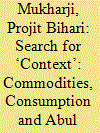

|
|
|
|
|
| Summary/Abstract |
Abul Hasanat (1905–?) was one of the most widely read Bengali sexologists. Having started researching in British India, he subsequently became a citizen of Pakistan and later of Bangladesh. He continued to research and publish throughout these changing political contexts. In this paper, I explore the difficulties in adequately ‘contextualising’ Hasanat’s sexology and propose instead the notion of a ‘material sexscape’ as the appropriate frame within which to locate his work.
|
|
|
|
|
|
|
|
|
|
|
|
|
|
|
|
| 12 |
ID:
171302
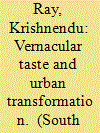

|
|
|
|
|
| Summary/Abstract |
The pleasure of street food provides an opening into the politics and poetics of vernacular taste. Mazaa in cheap viands such as chaat, kebabs and vada pao has the potential to decolonise the palatal and philosophical expectations of gastronomy that are dominant today. Viewed from the bottom up, much street food is a study of mazaa and poor people’s livelihoods in a matrix of cross-class interests. This paper takes the case of popular food cultures—based on a large multi-city collaborative project—to explore questions of liveliness of cities and epistemologies of fun. What are the best ways to register a bottom-up, sensuous materiality and sociability in theory without falling into the gourmand’s trap of pure apolitical pleasure?
|
|
|
|
|
|
|
|
|
|
|
|
|
|
|
|
|
|
|
|
|